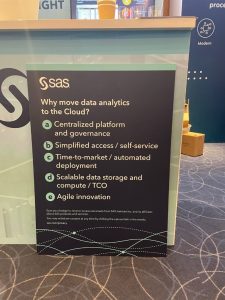After two years of virtual events we finally got the chance to attend (an in-person event at) the Gartner Data & AI Summit that took place in London. Keen to take advantage of the combined knowledge and experience of the +1500 attendees, we decided to ask them a question at the SAS booth related to the theme of the Conference: data, analytics, and the cloud. Each day we posed a fresh question with five possible answers – simply to solicit the opinion of the delegates.

Now just to be clear, this survey was not executed in a particularly scientific manner nor indeed were any of the answers deliberately more valid than the others. While our idea was to use this simply as a topic for conversation, the exercise snowballed judging by the number of weighty discussions that occurred at our booth.
Sometimes the discussion would begin with just a single attendee, but after a few minutes a small crowd of visitors gathered to express their opinions on the topic. As a result, we learned so much during these three days. Therefore, we would like to provide feedback on our findings. Feel free to comment, as the discussion should continue!
Why move data analytics to the cloud?
The Day #1 topic was “Why move data analytics to the cloud?” and we offered participants these answers, asking them to rank them in importance (first to third):
1. Centra lised platform and governance.
lised platform and governance.
2. Simplified access / self-service.
3. Time-to -market / automated deployment.
4. Scalable data storage and compute / total cost of ownership (TCO).
5. Agile innovation.
Not that you can tell from the picture, but the answer that received most votes was, “Scalable data storage and compute / TCO”, with “Agile innovation” followed closely at second place.
I had an interesting discussion with one of the attendees about the benefits a centralised platform and governance and the impact of an analytical centre of excellence to establish and evangelise best practices to the community of business users.
In his organisation, the COE function publishes a monthly newsletter and has set up internal communities to foster collaboration. They also promote an internal job rotation to give their data scientists the opportunity to see the ‘big picture’ and to show how data and analytics are more and more driving their entire operations.
Agile innovation
On the agile innovation topic we heard how some organisations embrace the cloud for its flexibility in experimentation. For example, one organization wanted to run an internal pilot to validate the analytical value of using images alongside their traditional (more structured) data and needed access to specialized GPU hardware. Using a cloud-based service, they were able to get immediate access to GPUs. This allowed them to run their experiments and decide afterwards whether it made sense to acquire such hardware, or scale the experiment further on the cloud.
Scalable data storage and compute
This example is a convenient segue to the most popular answer of the day: scalable data storage and compute / TCO. Clearly its pay-as-you-go model, the attraction of cost control and reducing the total cost of ownership were clearly underlying arguments for moving to the cloud. An interesting topic that also showed up elsewhere at the conference as one of the challenges and barriers to move to the cloud. More on this topic will follow in our next blog post. So stay tuned!

1 Comment
Curiosity is at most the driver in the technical areas. Hybrid clouds architectures seems to be state of the art in the moment.